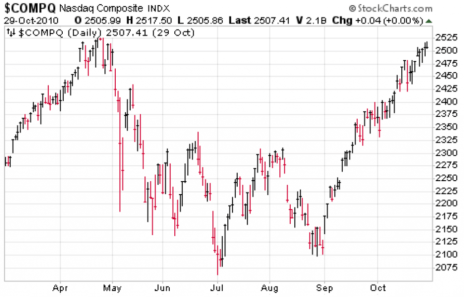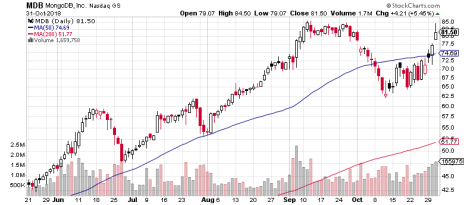No matter what stocks you own, I think we can all be thankful for one thing: October 2018 is now in the history books. Yes, there were a couple of areas left unscathed (mostly defensive types like utility stocks and consumer staples), but just about everything else got cut off at the knees in what was basically a slow-motion, month-long market crash in many names.
When the wounds heal, I’ll go back and review things as I always do, looking for a new Do or Don’t to add to our collection of rules and tools (probably while sipping on a Manhattan to ease the pain). But right now, with the downtrend in effect, I’m sitting in a defensive stance (more than three-quarters in cash) and focusing mostly on identifying a tradable low in the market and potential leading stocks of the next sustained uptrend.
Today, as we work through this market crash, I want to share 5 investing tricks to keep in mind—tricks that will help you keep a level head, avoid mistakes and, ideally, be early in spotting some new winners once the buyers re-take control.
5 Investing Tricks for Any Market Crash
Investing Trick #1: Bottoms are Usually a Process, Not an Event
Sure, there are the rare occasions when a steep market downtrend ends in a single day and leads to a sustained advance. The brief rout following the 9/11 terror attacks was one, and we saw something similar during the Ebola scare in October 2014. So you can never say never in the stock market.
[text_ad]
But in the vast majority of the corrections, market bottoms are a process, not a one- or two-day event. Instead, you often see one or two retests or at least some bobbing and weaving even after you hit the ultimate low. The market correction in 2010 was a perfect example—after the initial “flash crash” in early May, you can see the Nasdaq dipped to the 2,100 to 2,150 area numerous times in the months ahead before resuming its run in September.
To be clear, I’m not saying we necessarily have four months of retests and bottom building ahead of us; every situation is different, so don’t try to put a time frame on it. But just keep in mind that the odds are against the first low leading to a sustained advance.
Investing Trick #2: Good Stocks Can Go Bad in a Hurry in Bad Markets
On one hand, down markets can be “good” in the sense that they’re revealing—you can get a sense for what stocks institutions are hesitant to sell (or eager to buy on weakness), which is a huge help in getting off to a good start when a new uptrend gets underway.
However, it’s also frustrating to build watch lists because they’ll change so frequently; many stocks that have good charts one week will implode the next. One of many recent examples was WPX Energy (WPX), a fast-growing energy explorer that was still sitting in its prior base in mid October, but has since fallen apart, sinking with the rest of its sector and now meandering below its 200-day moving average.
Besides the overall market trend, this is the key reason why you should keep any buying to small sizes in a downtrend—today’s potential leader can be road kill tomorrow.
Investing Trick #3: Use a Proven System to Find “Bargains”
If I’ve gotten one email like this over the years, I’ve gotten 10,000: “Mike, I see that XYZ stock is down sharply during the past month, but the fundamentals look fine and the company is obviously a great one. I’m thinking of buying more shares down here. Thoughts?”
I’m not against the general idea of buying dips. But it’s important to understand that just because a stock is down 20% in the past month doesn’t mean it’s “cheap” or a bargain. Heck, if making money was that easy we’d all be rich. But as we repeatedly see in the stock market, even “good” companies can see their stocks get nailed and stay down for a long time; Facebook (FB) this year is a good example of that.
Instead, to find leaders, you need to have a system. If buying cheap is your thing, take a look at Crista Huff’s Cabot Undervalued Stocks Advisor, which uses valuations, earnings estimates, sector trends and (a little) stock action to find names that will outperform in the months ahead. Click here to learn more.
Now, if you’re more of a growth guy or gal, my Cabot Growth Investor combines feedback from the market itself (both market timing and the action of individual stocks) and fundamental stories and numbers to identify the next crop of leadership. These stocks might not seem “cheap” but big investors think they are! To find out what stocks I’m recommending now, click here.
The point is that there are time-tested methods to find winning ideas. Use them, and not gut feel.
Investing Trick #4: Don’t Obsess Over the Why
In a market downtrend, some of the biggest obstacles investors face is simply staying focused—intraday volatility, dramatic headlines and even more dramatic predictions might be good for clicks or TV ratings, but they don’t help investors keep their eye on the ball.
This week alone I’ve gotten a handful of emails that asked my opinion about why the market was declining, and what it portended for the future. Was it the U.S.-China trade war? Interest rates? The midterm elections? The cold, hard fact is that nobody knows—and even if you knew, it won’t help you make money.
(Actually, it’s probably a good bet that we’ll have more “reasons” for the October slide in the weeks ahead, as the market tends to discount the future. Said another way, there’s probably a reason for the decline, but we might not know what it is yet.)
Now, if you want to talk around the dinner table about why people think the market is doing this or that, by all means have at it. But when you’re making investment decisions, 100% of your focus should be on facts (market trend, fundamentals, price and volume, etc.) and not opinions or news.
Investing Trick #5: Remember—Big Money Awaits!
After a punishing month, it’s hard to see the light at the end of the tunnel. But having been at this for nearly 20 years and having seen some of the biggest bull and bear markets and everything in between, I can conclusively say: The big money is made in the big swing, owning a good-sized position in a new (usually little known) leader near the start of a new sustained market advance.
That’s the situation that will be appear sometime down the road—instead of choosing among stocks that have already had huge runs for many months (or years) and are obvious to many investors, we’ll be choosing from stocks that have already shaken out all the weak hands and that big investors are itching to build big positions in—a process that takes a long time and drives the share price higher.
One newer name featured in the most recent issue of Cabot Top Ten Trader is MongoDB (MDB), whose story is a bit of an ice-cream headache. But the basic story seems simple enough—the company looks like the leading provider of new-age database platforms that are document based (instead of rows and columns), can work with unstructured and machine data (instead of just structured data), can be used on-premise or in the cloud and be used/edited by co-workers around the world.
There is competition, but MongoDB is the leader of this movement, with as many downloads of its database app (it has a “freemium” business model, allowing free downloads and then upselling customers from there) as all its new-age competitors combined. Thus, it’s dominating a huge market that’s undergoing a dramatic shift—and that’s why the stock is strong. Revenues have grown between 48% and 61% each of the past nine quarters, while customer growth (7,400 at the end of April, up 72% from a year ago) is soaring and customers spending at least $100,000 annually with MongoDB rose 48%. The firm is still earnings and cash-flow negative, and revenue growth is expected to decelerate a bit, but big investors are looking at the overall potential should the company’s platform become the gold standard in the industry.
It’s a very big idea, and as of now, MDB is one of the few stocks hovering near its 50-day line. As I wrote above, there’s nothing that says the stock can’t fall apart if the market stays weak, but this is one name that should go on your watch list.
To get the names of additional fast-growing stocks, consider joining Cabot Top Ten Trader.
[author_ad]




